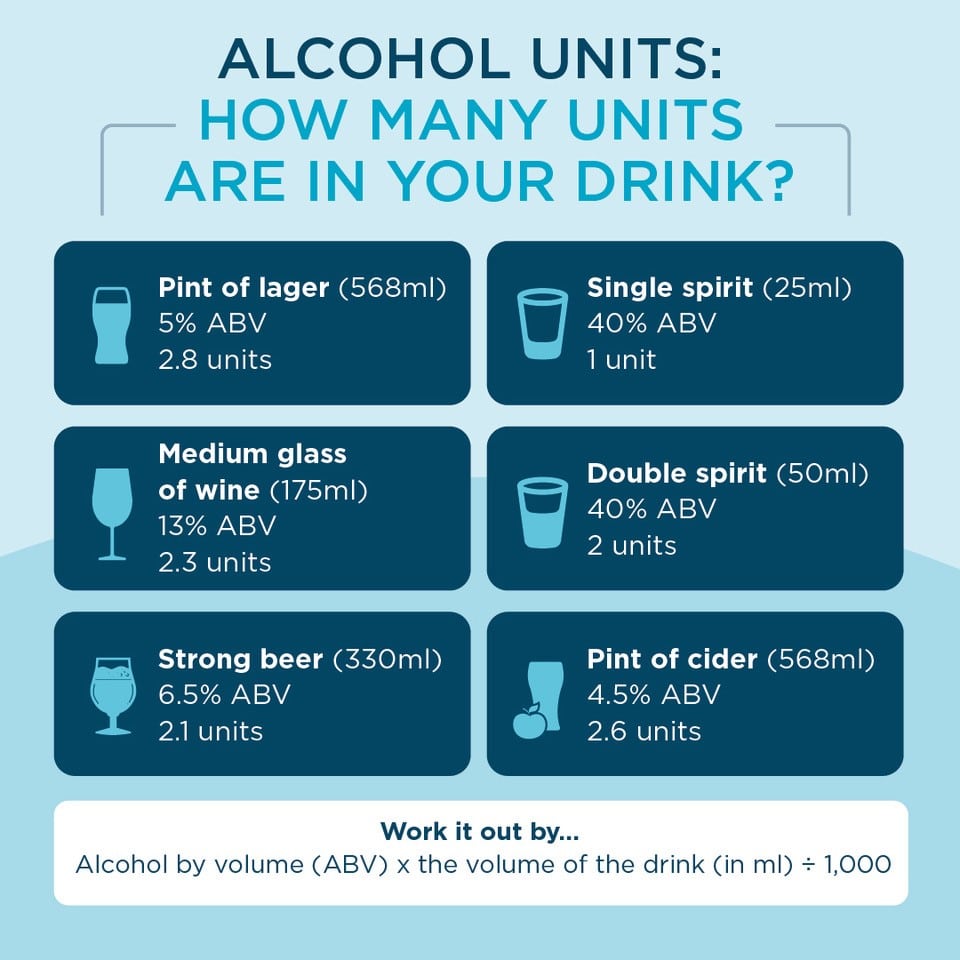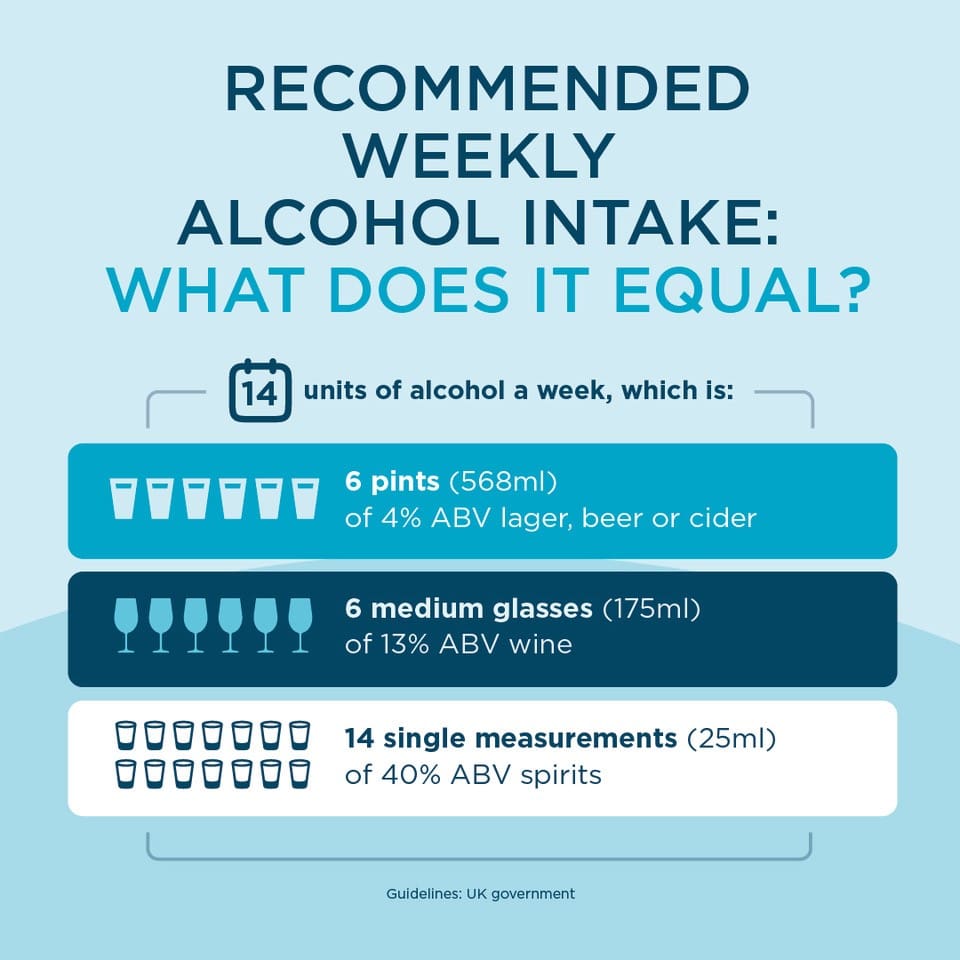Alcohol units: what they are, how they're measured and alcohol guidelines in the UK
Here, we discuss the facts about alcohol units so you can be better informed the next time you have a drink.
Here, we discuss the facts about alcohol units so you can be better informed the next time you have a drink.



Choosing alcohol can be confusing, with many options and a complex way of measuring alcohol content. It's hard to know how much alcohol you're drinking.
A unit of alcohol is a measure of the amount of pure alcohol in a drink. Here, we explain how it's measured. We also provide tips to help you understand how many units are in a drink.
Want to drink less or know how much you're drinking? Read on to find out more.
A unit of alcohol is a straightforward, standardised method of measuring the actual amount of pure alcohol in a drink. Alcoholic beverages come in different sizes, with different strengths of alcohol inside them. The unit system helps you to calculate the alcohol content of a drink. It also allows you to compare it to other drinks of varying sizes and types.
In the UK, one unit equals 10ml or 8g of pure alcohol. As an example, an average strength pint of beer, or 175ml glass of wine, total around two units of alcohol.
Read below to find out how units of alcohol are calculated.
Alcohol by volume (ABV) is a standard measure to quantify the amount of alcohol in an alcoholic beverage. It's expressed as a volume percent, which means it shows what portion of the total volume of liquid is alcohol.
If a bottle of wine has an ABV of 13%, it means that 13% of the total volume is pure alcohol. ABV gives us a clear idea of how strong (or alcoholic) a drink is.
Paying attention to the ABV of your drinks is an important part of keeping track of your alcohol units. Stronger drinks have more alcohol, so they will contain more units if you drink a lot. A strong wine has more units than a weaker one, even if the glass size is the same.
Beers and ciders typically contain 2% to 8% alcohol. Wines contain 8% to 14%. Spirits such as whisky, rum, vodka, and gin are much stronger, with an alcohol content of 35% to 40%.
Understanding ABV can help you gauge your alcohol intake and make informed decisions about your drinking habits.
Drinks can have different amounts of alcohol depending on the type and size of the drink.
There is a simple formula you can apply to calculate the number of units in any alcoholic drink:
ABV x the volume of the drink (in ml) ÷ 1,000
Apply the formula above and you’ll find the total number of units in an alcoholic drink. As an example, a 4% pint of beer works out like this:
4 (ABV) x 568 (ml) ÷ 1,000 = 2.3 (units)
Using the formula above, we can calculate the number of units in some of the most popular alcoholic drinks.

| Drink (size) | ABV | Units |
|---|---|---|
| Pint of lager (568ml) | 4% | 2.2 |
| Glass of wine (175ml) | 13% | 2.3 |
| Pint of cider (568ml) | 4.5% | 2.5 |
| Single spirit (25ml) | 40% | 1 |
| Double spirit (50ml) | 40% | 2 |
| Strong beer (330ml) | 6.5% | 2.1 |
The UK government says men and women should not drink more than 14 units a week. This should be spread over 3 or more days and should include several alcohol-free days.
As a guide, this would amount to:
It takes about an hour for a person to process one unit of alcohol and have it leave their bloodstream. However, this can be different for each person and depends on how much and how fast you drink.

Use our free online alcohol testing tool to check your symptoms.
Alcohol affects the body in lots of different ways, and there are many health risks from alcohol. It also affects our ability to carry out a task like driving. Alcohol slows our reactions, impairs our judgement and affects the quality of our sight. Drinking any alcohol can make it harder to drive safely, so it's best to avoid it if you plan to drive.
The legal drink drive limit differs in the UK, depending on the country you’re in.
In England, Wales and Northern Ireland, the limit is:
In Scotland, the limit is:
You can find more information on these limits on the UK government website.
It's difficult to measure how much alcohol affects your driving because it depends on many things. These include your weight, age, sex, metabolism, and how much you've eaten. It's best to avoid any alcohol if you're driving.
If you’re finding that your alcohol consumption is getting out of control, it could be time to reach out for support. Speak to your GP for initial guidance, but consider private treatment for alcohol addiction with Priory. We provide outstanding treatment for addiction throughout our network of UK rehab centres.
Use the information below to get in touch with Priory’s team and book a free, no-obligation addiction assessment.
Today, beer or ale comes in all kinds of sizes and strengths. Lower-strength beers (between 4% and 6% ABV) will usually come in pints – ranging from two to three units.
European beers often have higher alcohol content (6% to 9% or more). They are usually served in 330ml glasses, which is two-thirds of a pint. The units in these beers will vary significantly depending on strength and size.
For example:
6.5 (ABV) x 330 (ml) ÷ 1,000 = 2.1 (units)
A standard 750ml bottle of wine at 13% ABV has about 10 units. A standard medium glass of wine is 175ml, totalling about two units.
For example:
13 (ABV) x 175 (ml) ÷ 1,000 = 2.3 (units)
A double measures of spirits is 50ml. Spirits come in different strengths, but tend to range between 35% to 40% ABV. If we take a double measure of 40% ABV vodka for example, this will contain about two units.
For example:
40 (ABV) x 50 (ml) ÷ 1,000 = 2.4 (units)
If a double is 50ml, you might expect a single to be 25ml. In many pubs and bars, this will be the case. However, as Drinkaware points out, many places will use a 35ml measurement when pouring single measurements. A 25ml shot is just over one unit, but check the measurements at the pub or bar; 35ml will be more.
For example:
40 (ABV) x 35 (ml) ÷ 1,000 = 1.4 (units)
One pint of lager (568ml), which is usually between 3.5% and 5.5% alcohol, can have two to three units.
For example:
4 (ABV) x 568 (ml) ÷ 1,000 = 2.2 (units)
Get free monthly tips, tools and expert videos to support your mental health.
That's all in The Reset, helping you support your wellbeing - directly to your inbox each month.
